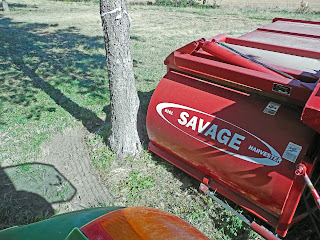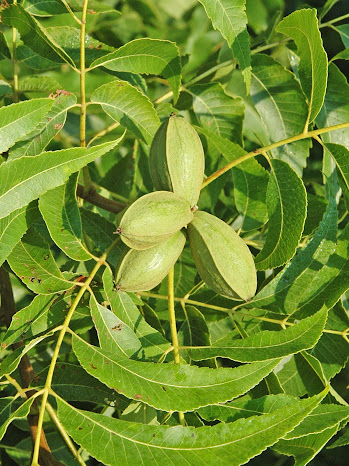One rainy day in May, I was leafing through my pecan magazines when I came across a photo of a Georgia Extension agent discussing the pruning of a young tree (photo at right). To me, this one photo illustrates many of the worst possible approaches to young tree training. The first thing I noticed was that far too many lower limbs have been removed during previous years. Lower limbs are vital for stimulating trunk diameter growth (making a strong trunk) and provide valuable leaf area to promote root growth. The second obvious problem was loss of a central leader and the development of a crow's foot at the top of the tree. Dormant pruning can be used to correct a crow's foot branch pattern with the selection of a single shoot to become the new central leader but when that new shoot breaks bud in the spring, a new crows foot will develop 3 feet higher in the tree.
I have discussed my approach to training young pecan trees is a series of blog posts published 10 years ago in this blog (Series starts HERE). Starting in mid-May and continuing through early June, I've been pruning my pecan trees using my directive pruning methods. This blog post is dedicated to illustrating the summer pruning cuts I make to direct a pecan tree's growth to ensure I create a well branched central leader tree.
The photo at left shows the typical budbreak pattern of a young grafted tree. The graft union is painted white with the majority of new shoot growth clustered at the top of the tree. At this point, this tree would create a fabulous crow's foot if allowed to grow unchecked.
My first pruning decision was to choose which new shoot would become the new central leader. Last spring's late frost killed several emerging buds (seen as brown dried-up buds in photo at right) which promoted a profusion of new shoots to grow near the top of the tree. One new shoot was growing more vigorously than all the others (yellow arrow) So I choose that one shoot to become my new leader.
With a single pruning cut, my young tree was poised to grow a strong central leader (photo at left). However, several rapidly growing shoots just below the new leader were still in position to create unwanted competition for the leader.
Following my
2-foot pruning rule I pruned off any shoots on the main trunk that could possibly complete with the central leader (photo at right). I left lateral shoots growing lower down on the trunk to help build a healthy canopy of new shoots and leaves to promote trunk diameter growth and rapid root growth.
With just a few summer pruning cuts, I directed the growth of this young tree into a more desirable tree shape (photo at left). I'll need to come back to this three in mid summer to remove any shoots developed from stalked buts and to tip back the growth of laterals.
When summer pruning my trees I look for trees that have developed what what I like to call 'lolly-pop' tops. The photo at right is typical of this kind of growth. What you are actually seeing is the early stages of the 'crow's foot' growth pattern.
Using my ladder, I climbed up to take a close look at the top of the tree (photo above). In typical fashion this tree developed multiple shoots at the tree's apex. To re-establish a central leader, I pruned off all competing shoots leaving just one to become dominate. What I'm actually doing is pruning out a crow's foot while the shoots are still growing upright and before they start spreading out laterally in all directions (to form the typical crow's foot).
Pruning in the summer has the advantage of removing far less wood material than what is common with dormant pruning. The green shoots I prune off can be left on the ground to be chewed up when I mow the grove.
By pruning out the 'lolly-pop' I have recovered a single central leader (photo at left). However, my summer pruning efforts on tree are not finished.
On this size tree, I tip prune new lateral shoots once they have grown about 2 feet in length. This slows extension growth and encourages shoot diameter growth. When pruning lateral shoots, I always prune to an outward pointing bud (photo above). I also remove any new lateral shoots that are pointing straight upwards.




















































